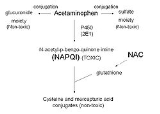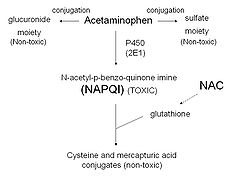
King's College Criteria
Encyclopedia
The King's College Criteria or the King's College Hospital criteria were devised in 1989 to determine if there were any early indices of poor prognosis in patients with acute liver failure. Acute liver failure is defined as the onset of encephalopathy
(altered mental status) or coagulopathy
(altered bleeding tendencies) within 26 weeks of a patient diagnosed with liver disease. Patients with hepatitis B acquired at birth, Wilson's disease
and autoimmune hepatitis
are included if their disease was identified within the past 26 weeks. These patients are very ill, and have a very high risk of dying of their illness without adequate treatment which may include liver transplantation
. It is important that physicians find ways of identifying patients with acute liver failure early in their course who will do poorly, and may require liver transplantation. The King's College Criteria have consistently shown excellent operating characteristic
s for determining prognosis in these patients. As liver transplantation
becomes a more accessible option for patients with acute liver failure, the King's College Criteria serve a role in determining which patients may require transplantation.
. 588 patients with acute liver failure who presented to King's College Hospital from 1973 to 1985 were assessed retrospectively to determine if there were particular clinical features or tests that correlated poorly with prognosis. The criteria were stratified into acetaminophen and non-acetaminophen causes of acute liver failure, due to the different operating characteristics of parameters correlating with prognosis in the two causes.
 Acetaminophen (or paracetamol
Acetaminophen (or paracetamol
) is an analgesic
medication that can affect the liver when administered in high doses. Acetaminophen is predominantly conjugated into glucuronate and sulfate
moieties by Phase II metabolism. A small percentage is metabolized by the cytochrome P450 pathway to a toxic metabolite, NAPQI. NAPQI is conjugated by glutathione
to non-toxic cysteine and mercapturic acid moieties. In cases of acetaminophen toxicity, the Phase II conjugation enzymes are saturated, and a higher fraction is converted to NAPQI. The conjugation of NAPQI to glutathione occurs until glutathione is depleted from hepatic reserves, after which the toxic NAPQI accumulates and causes damage to the hepatocytes. This occurs primarily in areas of the liver that are relatively poorly perfused with oxygen, or furthest away from the hepatic artery
, termed Zone 3. Acetaminophen overdose is associated with Zone 3 necrosis, to the point that acute liver failure may result.
The King's College Criteria identify two groups of patients that have a poor prognosis with acetaminophen induced liver failure:
 There are many causes of acute liver failure aside from acetaminophen toxicity; these include viral hepatitis -- including hepatitis A
There are many causes of acute liver failure aside from acetaminophen toxicity; these include viral hepatitis -- including hepatitis A
(rarely), hepatitis B, hepatitis C
(rarely), hepatitis E
(especially in pregnant women), Epstein-Barr Virus
, cytomegalovirus
and varicella-zoster virus -- Wilson's disease
, the toxin of the death cap
mushroom
(Amanita phylloides), alcohol
, autoimmune hepatitis
, Budd-Chiari syndrome
, other medications (including halothane
, hormonal contraception
, and isoniazid
), recreational drugs (including ecstasyhttp://emedicine.medscape.com/article/169814-overview) and, rarely, tumours infiltrating the liver.
In patients with non-acetaminophen acute liver failure, the following criteria were identified as being associated with a poor prognosis:
of the criteria in predicting death from acute liver failure has ranged from 70% to 100%. A Canadian meta-analysis
assessing various prognostic indices found that the specificity of the King's College criteria in predicting mortality
exceeded 90%, with a sensitivity of 69%. As a result, the American Society for Study of Liver Diseases has recommended the King's College Criteria as being helpful early parameters in ascertaining the need for liver transplantation
in patients with acute liver failure.
) score has a comparable sensitivity to the King's College Criteria in determining prognosis.
Encephalopathy
Encephalopathy means disorder or disease of the brain. In modern usage, encephalopathy does not refer to a single disease, but rather to a syndrome of global brain dysfunction; this syndrome can be caused by many different illnesses.-Terminology:...
(altered mental status) or coagulopathy
Coagulopathy
Coagulopathy is a condition in which the blood’s ability to clot is impaired. This condition can cause prolonged or excessive bleeding, which may occur spontaneously or following an injury or medical and dental procedures.The normal clotting process depends on the interplay of various proteins in...
(altered bleeding tendencies) within 26 weeks of a patient diagnosed with liver disease. Patients with hepatitis B acquired at birth, Wilson's disease
Wilson's disease
Wilson's disease or hepatolenticular degeneration is an autosomal recessive genetic disorder in which copper accumulates in tissues; this manifests as neurological or psychiatric symptoms and liver disease...
and autoimmune hepatitis
Autoimmune hepatitis
Autoimmune Hepatitis is a disease of the liver that occurs when the body's immune system attacks cells of the liver. Anomalous presentation of human leukocyte antigen class II on the surface of hepatocytes, possibly due to genetic predisposition or acute liver infection, causes a cell-mediated...
are included if their disease was identified within the past 26 weeks. These patients are very ill, and have a very high risk of dying of their illness without adequate treatment which may include liver transplantation
Liver transplantation
Liver transplantation or hepatic transplantation is the replacement of a diseased liver with a healthy liver allograft. The most commonly used technique is orthotopic transplantation, in which the native liver is removed and replaced by the donor organ in the same anatomic location as the original...
. It is important that physicians find ways of identifying patients with acute liver failure early in their course who will do poorly, and may require liver transplantation. The King's College Criteria have consistently shown excellent operating characteristic
Receiver operating characteristic
In signal detection theory, a receiver operating characteristic , or simply ROC curve, is a graphical plot of the sensitivity, or true positive rate, vs. false positive rate , for a binary classifier system as its discrimination threshold is varied...
s for determining prognosis in these patients. As liver transplantation
Liver transplantation
Liver transplantation or hepatic transplantation is the replacement of a diseased liver with a healthy liver allograft. The most commonly used technique is orthotopic transplantation, in which the native liver is removed and replaced by the donor organ in the same anatomic location as the original...
becomes a more accessible option for patients with acute liver failure, the King's College Criteria serve a role in determining which patients may require transplantation.
Criteria
The King's College criteria were described in a seminal publication in 1989 by J.G. O'Grady and colleagues from King's College School of MedicineKing's College London
King's College London is a public research university located in London, United Kingdom and a constituent college of the federal University of London. King's has a claim to being the third oldest university in England, having been founded by King George IV and the Duke of Wellington in 1829, and...
. 588 patients with acute liver failure who presented to King's College Hospital from 1973 to 1985 were assessed retrospectively to determine if there were particular clinical features or tests that correlated poorly with prognosis. The criteria were stratified into acetaminophen and non-acetaminophen causes of acute liver failure, due to the different operating characteristics of parameters correlating with prognosis in the two causes.
Acetaminophen induced acute liver failure

Paracetamol
Paracetamol INN , or acetaminophen USAN , is a widely used over-the-counter analgesic and antipyretic . It is commonly used for the relief of headaches and other minor aches and pains and is a major ingredient in numerous cold and flu remedies...
) is an analgesic
Analgesic
An analgesic is any member of the group of drugs used to relieve pain . The word analgesic derives from Greek an- and algos ....
medication that can affect the liver when administered in high doses. Acetaminophen is predominantly conjugated into glucuronate and sulfate
Sulfate
In inorganic chemistry, a sulfate is a salt of sulfuric acid.-Chemical properties:...
moieties by Phase II metabolism. A small percentage is metabolized by the cytochrome P450 pathway to a toxic metabolite, NAPQI. NAPQI is conjugated by glutathione
Glutathione
Glutathione is a tripeptide that contains an unusual peptide linkage between the amine group of cysteine and the carboxyl group of the glutamate side-chain...
to non-toxic cysteine and mercapturic acid moieties. In cases of acetaminophen toxicity, the Phase II conjugation enzymes are saturated, and a higher fraction is converted to NAPQI. The conjugation of NAPQI to glutathione occurs until glutathione is depleted from hepatic reserves, after which the toxic NAPQI accumulates and causes damage to the hepatocytes. This occurs primarily in areas of the liver that are relatively poorly perfused with oxygen, or furthest away from the hepatic artery
Hepatic artery
Hepatic artery can refer to:* Common hepatic artery * Hepatic artery proper...
, termed Zone 3. Acetaminophen overdose is associated with Zone 3 necrosis, to the point that acute liver failure may result.
The King's College Criteria identify two groups of patients that have a poor prognosis with acetaminophen induced liver failure:
- Arterial pH < 7.3 (taken by sampling of blood from an artery)
- All three of an international normalized ratio (INR) of greater than 6.5, serum creatinine of greater than 300 micromoles per litre and the presence of encephalopathy (of grade III or IV). These three are markers of coagulopathyCoagulopathyCoagulopathy is a condition in which the blood’s ability to clot is impaired. This condition can cause prolonged or excessive bleeding, which may occur spontaneously or following an injury or medical and dental procedures.The normal clotting process depends on the interplay of various proteins in...
, kidney functionAcute renal failureAcute kidney injury , previously called acute renal failure , is a rapid loss of kidney function. Its causes are numerous and include low blood volume from any cause, exposure to substances harmful to the kidney, and obstruction of the urinary tract...
and mental status.
Non-acetaminophen acute liver failure

Hepatitis A
Hepatitis A is an acute infectious disease of the liver caused by the hepatitis A virus , an RNA virus, usually spread the fecal-oral route; transmitted person-to-person by ingestion of contaminated food or water or through direct contact with an infectious person...
(rarely), hepatitis B, hepatitis C
Hepatitis C
Hepatitis C is an infectious disease primarily affecting the liver, caused by the hepatitis C virus . The infection is often asymptomatic, but chronic infection can lead to scarring of the liver and ultimately to cirrhosis, which is generally apparent after many years...
(rarely), hepatitis E
Hepatitis E
Hepatitis E is a viral hepatitis caused by infection with a virus called hepatitis E virus . HEV is a positive-sense single-stranded RNA icosahedral virus with a 7.5 kilobase genome. HEV has a fecal-oral transmission route. It is one of five known hepatitis viruses: A, B, C, D, and E...
(especially in pregnant women), Epstein-Barr Virus
Epstein-Barr virus
The Epstein–Barr virus , also called human herpesvirus 4 , is a virus of the herpes family and is one of the most common viruses in humans. It is best known as the cause of infectious mononucleosis...
, cytomegalovirus
Cytomegalovirus
Cytomegalovirus is a viral genus of the viral group known as Herpesviridae or herpesviruses. It is typically abbreviated as CMV: The species that infects humans is commonly known as human CMV or human herpesvirus-5 , and is the most studied of all cytomegaloviruses...
and varicella-zoster virus -- Wilson's disease
Wilson's disease
Wilson's disease or hepatolenticular degeneration is an autosomal recessive genetic disorder in which copper accumulates in tissues; this manifests as neurological or psychiatric symptoms and liver disease...
, the toxin of the death cap
Death cap
Amanita phalloides , commonly known as the death cap, is a deadly poisonous basidiomycete fungus, one of many in the genus Amanita. Widely distributed across Europe, A. phalloides forms ectomycorrhizas with various broadleaved trees. In some cases, death cap has been introduced to new regions with...
mushroom
Mushroom
A mushroom is the fleshy, spore-bearing fruiting body of a fungus, typically produced above ground on soil or on its food source. The standard for the name "mushroom" is the cultivated white button mushroom, Agaricus bisporus; hence the word "mushroom" is most often applied to those fungi that...
(Amanita phylloides), alcohol
Alcohol
In chemistry, an alcohol is an organic compound in which the hydroxy functional group is bound to a carbon atom. In particular, this carbon center should be saturated, having single bonds to three other atoms....
, autoimmune hepatitis
Autoimmune hepatitis
Autoimmune Hepatitis is a disease of the liver that occurs when the body's immune system attacks cells of the liver. Anomalous presentation of human leukocyte antigen class II on the surface of hepatocytes, possibly due to genetic predisposition or acute liver infection, causes a cell-mediated...
, Budd-Chiari syndrome
Budd-Chiari syndrome
In medicine , Budd–Chiari syndrome is the clinical picture caused by occlusion of the hepatic veins. It presents with the classical triad of abdominal pain, ascites and hepatomegaly. Examples of occlusion include thrombosis of hepatic veins. The syndrome can be fulminant, acute, chronic, or...
, other medications (including halothane
Halothane
Halothane is an inhalational general anesthetic. Its IUPAC name is 2-bromo-2-chloro-1,1,1-trifluoroethane. It is the only inhalational anesthetic agent containing a bromine atom; there are several other halogenated anesthesia agents which lack the bromine atom and do contain the fluorine and...
, hormonal contraception
Hormonal contraception
Hormonal contraception refers to birth control methods that act on the endocrine system. Almost all methods are composed of steroid hormones, although in India one selective estrogen receptor modulator is marketed as a contraceptive. The original hormonal method—the combined oral contraceptive...
, and isoniazid
Isoniazid
Isoniazid , also known as isonicotinylhydrazine , is an organic compound that is the first-line antituberculosis medication in prevention and treatment. It was first discovered in 1912, and later in 1951 it was found to be effective against tuberculosis by inhibiting its mycolic acid...
), recreational drugs (including ecstasyhttp://emedicine.medscape.com/article/169814-overview) and, rarely, tumours infiltrating the liver.
In patients with non-acetaminophen acute liver failure, the following criteria were identified as being associated with a poor prognosis:
- INR greater than 6.5; or,
- Three of the following five criteria:
- Patient age of less than 11 or greater than 40;
- Serum bilirubinBilirubinBilirubin is the yellow breakdown product of normal heme catabolism. Heme is found in hemoglobin, a principal component of red blood cells. Bilirubin is excreted in bile and urine, and elevated levels may indicate certain diseases...
of greater than 300 micromoles per litre; - Time from onset of jaundiceJaundiceJaundice is a yellowish pigmentation of the skin, the conjunctival membranes over the sclerae , and other mucous membranes caused by hyperbilirubinemia . This hyperbilirubinemia subsequently causes increased levels of bilirubin in the extracellular fluid...
to the development of comaComaIn medicine, a coma is a state of unconsciousness, lasting more than 6 hours in which a person cannot be awakened, fails to respond normally to painful stimuli, light or sound, lacks a normal sleep-wake cycle and does not initiate voluntary actions. A person in a state of coma is described as...
of greater than seven days; - INR greater than 3.5; or,
- Drug toxicity, regardless of whether it was the cause of the acute liver failure.
Utility in prediction
The utility of the criteria in determining the prognosis of patients with acute liver failure is defined by their operating characteristics. The positive predictive valuePositive predictive value
In statistics and diagnostic testing, the positive predictive value, or precision rate is the proportion of subjects with positive test results who are correctly diagnosed. It is a critical measure of the performance of a diagnostic method, as it reflects the probability that a positive test...
of the criteria in predicting death from acute liver failure has ranged from 70% to 100%. A Canadian meta-analysis
Meta-analysis
In statistics, a meta-analysis combines the results of several studies that address a set of related research hypotheses. In its simplest form, this is normally by identification of a common measure of effect size, for which a weighted average might be the output of a meta-analyses. Here the...
assessing various prognostic indices found that the specificity of the King's College criteria in predicting mortality
Death
Death is the permanent termination of the biological functions that sustain a living organism. Phenomena which commonly bring about death include old age, predation, malnutrition, disease, and accidents or trauma resulting in terminal injury....
exceeded 90%, with a sensitivity of 69%. As a result, the American Society for Study of Liver Diseases has recommended the King's College Criteria as being helpful early parameters in ascertaining the need for liver transplantation
Liver transplantation
Liver transplantation or hepatic transplantation is the replacement of a diseased liver with a healthy liver allograft. The most commonly used technique is orthotopic transplantation, in which the native liver is removed and replaced by the donor organ in the same anatomic location as the original...
in patients with acute liver failure.
Alternatives
A variety of other calculations have been done based on similar parameters to determine the risk of mortality in acute liver failure. The Acute Physiology and Chronic Health Evaluation II (APACHE IIAPACHE II
APACHE II is a severity-of-disease classification system , one of several ICU scoring systems...
) score has a comparable sensitivity to the King's College Criteria in determining prognosis.

